Unit 5 A tale with a twist 牛津上海课标版 高三上册 课件(18张PPT)
文档属性
| 名称 | Unit 5 A tale with a twist 牛津上海课标版 高三上册 课件(18张PPT) |
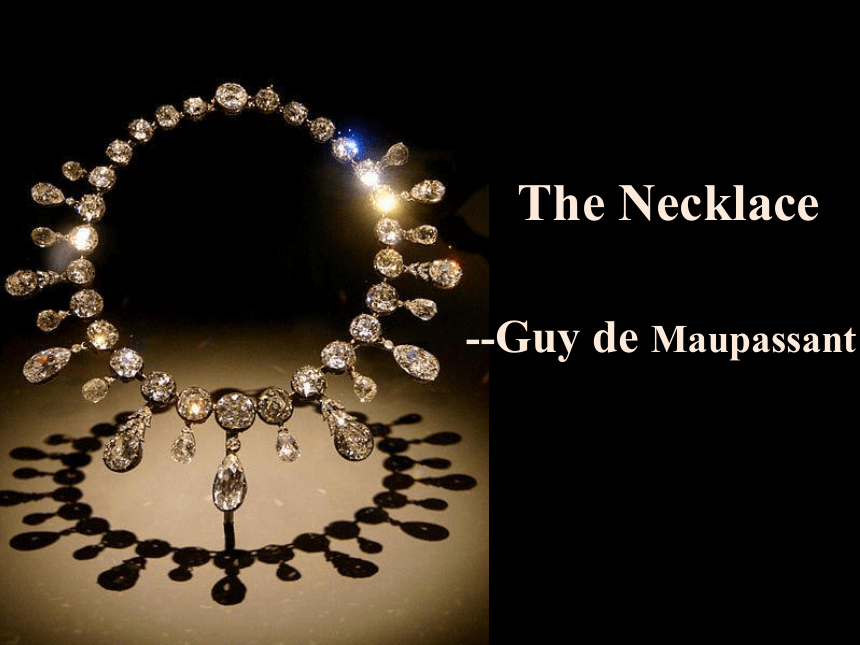
|
|
| 格式 | pptx | ||
| 文件大小 | 859.7KB | ||
| 资源类型 | 教案 | ||
| 版本资源 | 牛津上海版(试用本) | ||
| 科目 | 英语 | ||
| 更新时间 | 2020-09-23 15:55:52 | ||
图片预览


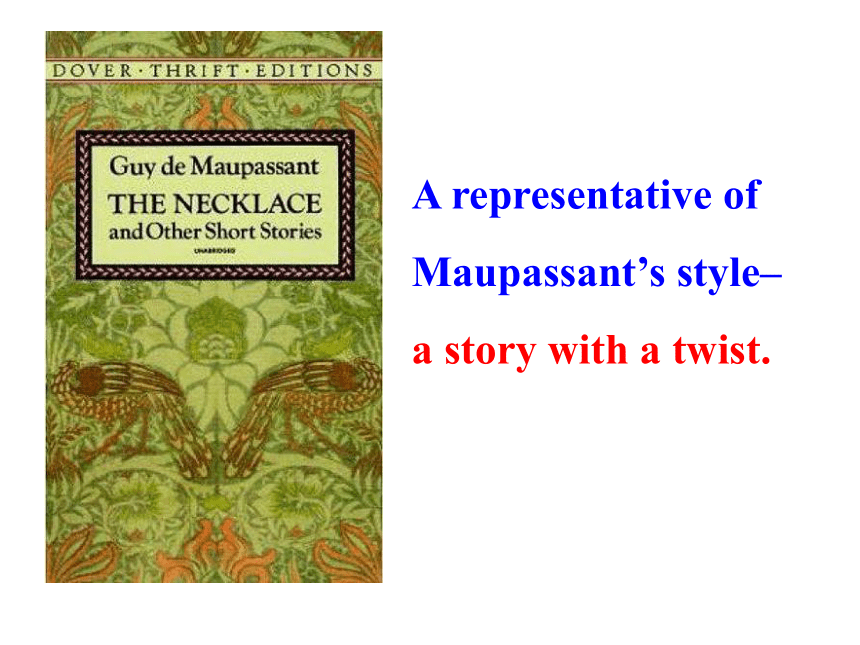
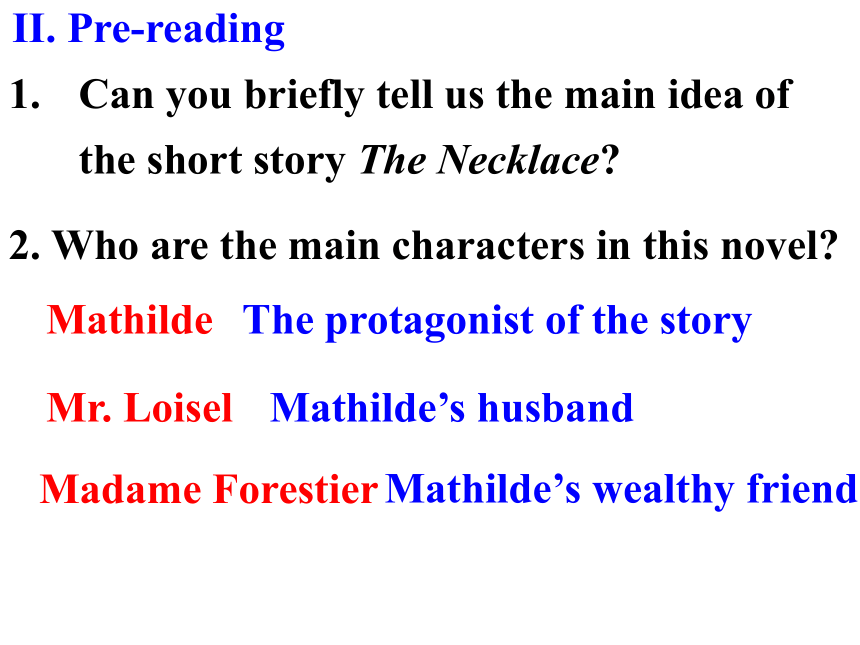
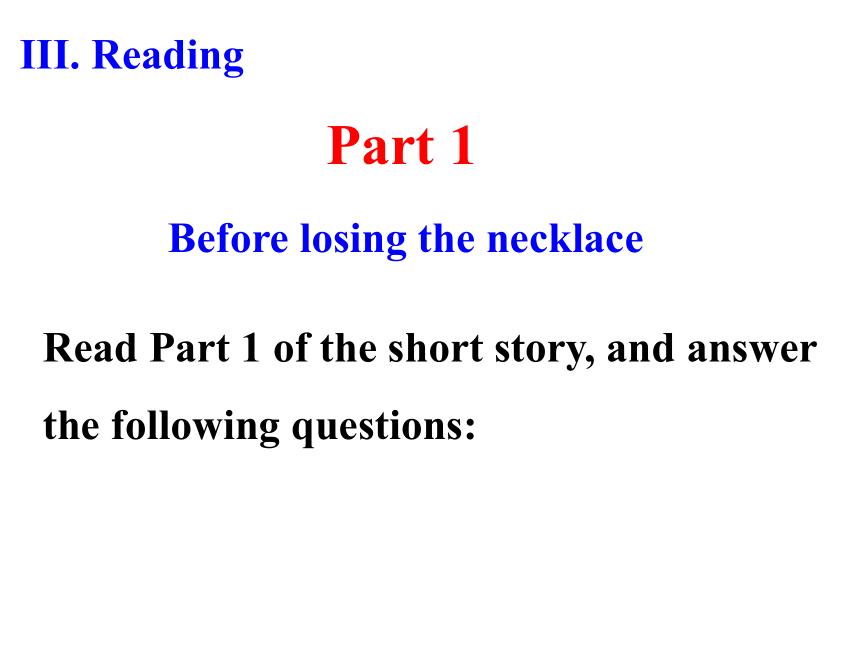
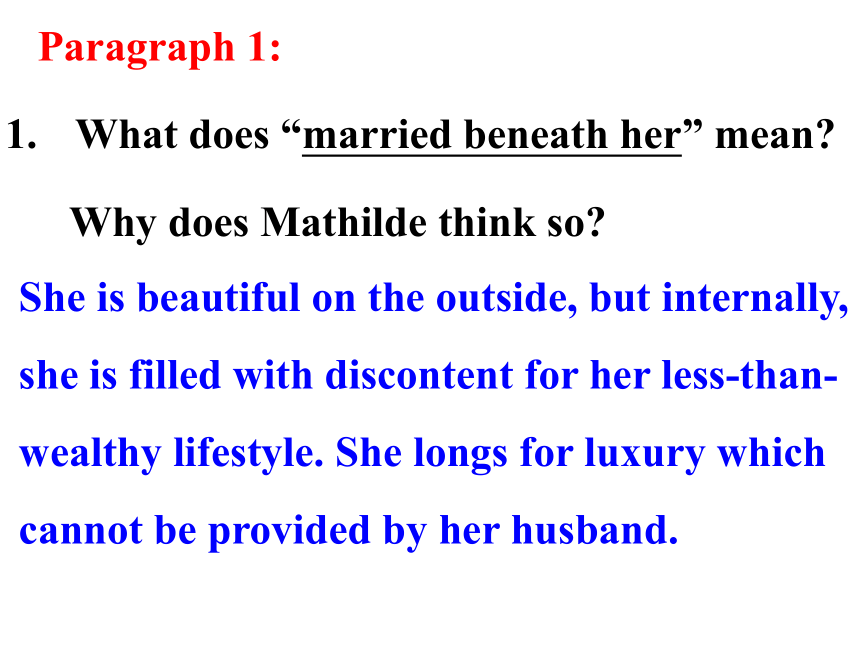
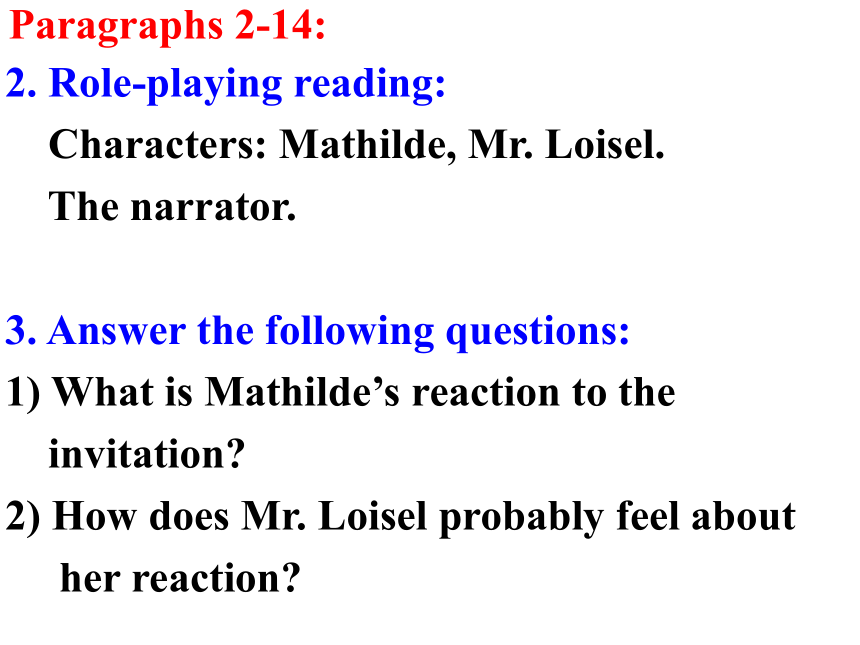
文档简介
The Necklace
--Guy de Maupassant
I. Background information
Times: ______________
Nationality:__________
Occupation:__________
Genre:_______________
19th century
French
novelist, short story writer
realism
depicted human lives and destinies and social forces truthfully and often in pessimistic terms
A representative of Maupassant’s style–
a story with a twist.
II. Pre-reading
Can you briefly tell us the main idea of the short story The Necklace?
2. Who are the main characters in this novel?
Mathilde
Mr. Loisel
Madame Forestier
Mathilde’s husband
Mathilde’s wealthy friend
The protagonist of the story?
Part 1
Read Part 1 of the short story, and answer the following questions:
III. Reading
Before losing the necklace
Paragraph 1:
What does “married beneath her” mean?
Why does Mathilde think so?
She is beautiful on the outside, but internally, she is filled with discontent for her less-than-wealthy lifestyle. She longs for luxury which cannot be provided by her husband.
2. Role-playing reading:
Characters: Mathilde, Mr. Loisel.
The narrator.
3. Answer the following questions:
1) What is Mathilde’s reaction to the
invitation?
2) How does Mr. Loisel probably feel about
her reaction?
Paragraphs 2-14:
3) What is implied in Paragraph 8, when Mr. Loisel said “…a suitable dress, which you could use on other occasions as well, something very simple?”
Paragraph 10, “He grew slightly pale.”
not wealthy, practical, economical
He worried about the cost of the dress.
Madame Forestier lent Mathilde the necklace
4) Is the party a success for Mathilde?
Part 2
Read Part 2 of the short story, and answer the following questions:
III. Reading
After losing the necklace
What changes happen to Mathilde after she loses the necklace?
{5C22544A-7EE6-4342-B048-85BDC9FD1C3A}
Before
After
life
appearance
psychology
Fine clothes and jewels were the
only things she loved.
She came to know the life of poverty. She came to know the heavy work of the house.
Charming,
admired, the prettiest woman
at the party
Looked old, like all the strong, hard, coarse women of poor households.
She had longed so eagerly to be
wildly attractive and sought after.
She thought of that evening long ago, of the ball at which she had been so beautiful and so much admired.
2. What does Mathilde mean by saying “all on your account” in Paragraph 13?
3. How would Mathilde probably react at the end of the story, when she found out the original necklace was a fake?
IV. Literature appreciation:
1) a twist / surprise ending
A twist ending is a literal technique, introducing an unexpected ending beyond
the readers’ original expectations.
Also known as “O Henry ending”
Shatters the readers’ illusion, adds irony,
raises the story to a higher level, sets readers rethinking.
2) symbolism.
A literary device to use an object, person, situation or word to represent something else, to give an entirely different meaning that is much deeper and more significant.
What is the most important symbol in the story?
The necklace, beautiful but worthless, represents the power of perception and the split between appearances and reality.
V. Further thinking
What kind of person is Mathilde ?
Is her ten years’ misery accidental or unavoidable?
What is the moral of the story?
1) Add an ending to the story.
2) Write a two-line poem with a twist.
Examples:
Kind, intelligent, loving and hot;
This describes everything you are not.
2) I love your smile, your face, and your eyes.
Damn, I'm good at telling lies!
VI. Assignment-- literary creation.
--Guy de Maupassant
I. Background information
Times: ______________
Nationality:__________
Occupation:__________
Genre:_______________
19th century
French
novelist, short story writer
realism
depicted human lives and destinies and social forces truthfully and often in pessimistic terms
A representative of Maupassant’s style–
a story with a twist.
II. Pre-reading
Can you briefly tell us the main idea of the short story The Necklace?
2. Who are the main characters in this novel?
Mathilde
Mr. Loisel
Madame Forestier
Mathilde’s husband
Mathilde’s wealthy friend
The protagonist of the story?
Part 1
Read Part 1 of the short story, and answer the following questions:
III. Reading
Before losing the necklace
Paragraph 1:
What does “married beneath her” mean?
Why does Mathilde think so?
She is beautiful on the outside, but internally, she is filled with discontent for her less-than-wealthy lifestyle. She longs for luxury which cannot be provided by her husband.
2. Role-playing reading:
Characters: Mathilde, Mr. Loisel.
The narrator.
3. Answer the following questions:
1) What is Mathilde’s reaction to the
invitation?
2) How does Mr. Loisel probably feel about
her reaction?
Paragraphs 2-14:
3) What is implied in Paragraph 8, when Mr. Loisel said “…a suitable dress, which you could use on other occasions as well, something very simple?”
Paragraph 10, “He grew slightly pale.”
not wealthy, practical, economical
He worried about the cost of the dress.
Madame Forestier lent Mathilde the necklace
4) Is the party a success for Mathilde?
Part 2
Read Part 2 of the short story, and answer the following questions:
III. Reading
After losing the necklace
What changes happen to Mathilde after she loses the necklace?
{5C22544A-7EE6-4342-B048-85BDC9FD1C3A}
Before
After
life
appearance
psychology
Fine clothes and jewels were the
only things she loved.
She came to know the life of poverty. She came to know the heavy work of the house.
Charming,
admired, the prettiest woman
at the party
Looked old, like all the strong, hard, coarse women of poor households.
She had longed so eagerly to be
wildly attractive and sought after.
She thought of that evening long ago, of the ball at which she had been so beautiful and so much admired.
2. What does Mathilde mean by saying “all on your account” in Paragraph 13?
3. How would Mathilde probably react at the end of the story, when she found out the original necklace was a fake?
IV. Literature appreciation:
1) a twist / surprise ending
A twist ending is a literal technique, introducing an unexpected ending beyond
the readers’ original expectations.
Also known as “O Henry ending”
Shatters the readers’ illusion, adds irony,
raises the story to a higher level, sets readers rethinking.
2) symbolism.
A literary device to use an object, person, situation or word to represent something else, to give an entirely different meaning that is much deeper and more significant.
What is the most important symbol in the story?
The necklace, beautiful but worthless, represents the power of perception and the split between appearances and reality.
V. Further thinking
What kind of person is Mathilde ?
Is her ten years’ misery accidental or unavoidable?
What is the moral of the story?
1) Add an ending to the story.
2) Write a two-line poem with a twist.
Examples:
Kind, intelligent, loving and hot;
This describes everything you are not.
2) I love your smile, your face, and your eyes.
Damn, I'm good at telling lies!
VI. Assignment-- literary creation.
